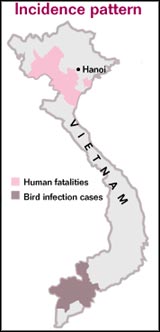Avian havoc
Avian havoc

vietnam is grappling with the severest ever attack of bird flu. The disease has killed five people so far, even as nine other influenza deaths are being examined. As a damage-control measure, Vietnam as well as some Southeast Asian countries have resorted to mass culling of poultry chickens.
The disease is caused by the h5n1 avian influenza virus. Nearly 2 million birds had already been killed in Vietnam at the last count. The flu has ravaged poultry farms in a quarter of the country's 58 provinces, particularly those in the south and north. Curiously, the suspected human cases have been reported in the northern provinces while the bulk of bird infections have occurred in the south (see map: Incidence pattern). Vietnam's ministry of agriculture and rural development has banned the transportation of chickens and other poultry from the southern provinces. Mass culling of birds has also been undertaken in South Korea, Japan and Taiwan.
The World Health Organisation (who), which has confirmed that the fatal infection had caused five deaths, is currently studying the nine other cases. It maintained that the five victims had contracted the infection from sick birds and ruled out human-to-human transmission. "Should this occur, we would have a serious situation. We are mainly worried about the possibility of avian virus acquiring full capacity to transmit from one person to another,' said Shigeru Omi, who's regional director in Manila. Experts fear that a new subtype that can transmit the infection among humans could cause the next influenza pandemic. The first such pandemic in the last century (1918-19) caused an estimated 40-50 million deaths worldwide. The other two pandemics occurred in 1957-58 and 1968-69.
Another dangerous signal has emerged in a southern Vietnamese province where many pig deaths were reported. Spreading of the infection to pigs may have dangerous ramifications as they are susceptible to infection from both avian and mammalian viruses, including human strains. Pigs may serve as a medium where the genetic material from human and avian viruses could mix. This would result in the emergence of a novel subtype. Avian flu is highly infectious, and spreads through contact with bird droppings. The h5n1 pathogen mutates rapidly and has the tendency to acquire genes from viruses infecting other animal species.
Meanwhile, a medical team of the us Centers for Disease Control and Prevention has reached Vietnam to help in controlling the outbreak.
Developing a vaccine could take at least four months from the time of the outbreak, by when the disease would have wrought havoc, fear experts. Through different agricultural practices, humans are said to have altered the ecosystems of many animal species, which have created ideal conditions for the emergence of novel influenza virus strains.







